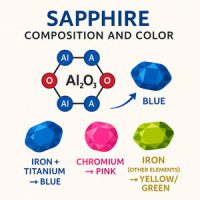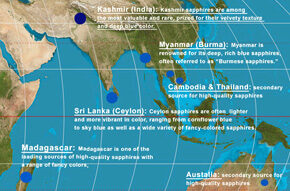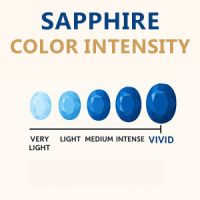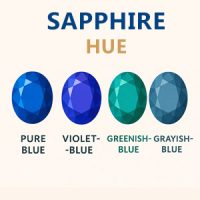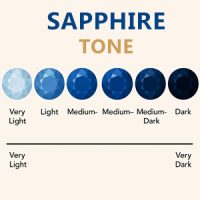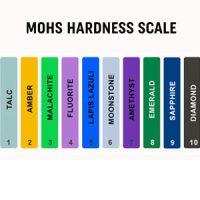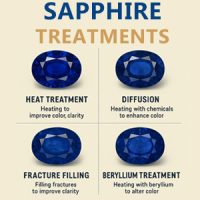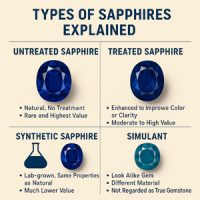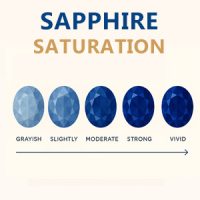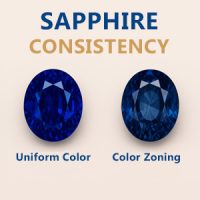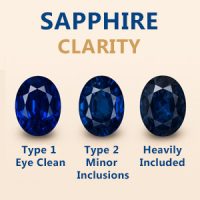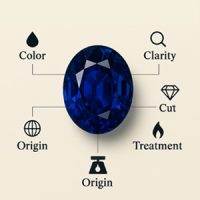SAPPHIRES
Sapphires are one of the three precious colored gemstones. The others being Rubies and Emeralds. It is a variety of the mineral Corundum which is a mineral that includes both sapphires and rubies. Red corundum is known as ruby and all other colored corundum are known as sapphires with blue being the most common. Sapphires that are not blue are known as fancy sapphires and can occur in yellow, purple, orange, and green colors; “parti sapphires” show two or more colors. Sapphires are the single most versatile stone with so many color choices and a hardness only beaten by diamonds..
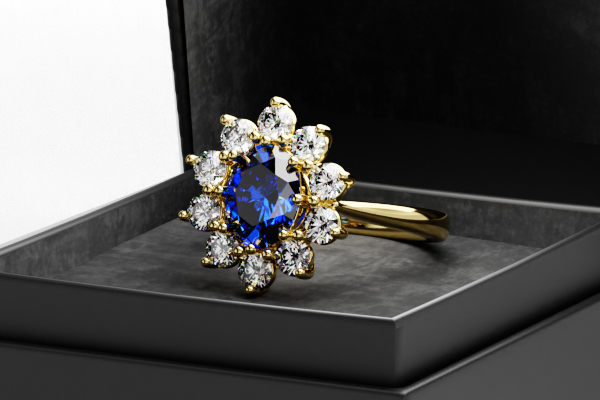
Composition, Formation & Origins
Chemically, sapphires are composed of aluminum oxide (Al₂O₃). What gives sapphires their stunning colors are trace elements that become incorporated into the crystal structure during formation. For example:
Blue sapphires owe their color to the presence of iron and titanium.
Pink sapphires contain traces of chromium.
Yellow and green sapphires are influenced by a combination of iron and other elements.
Sapphires have a trigonal crystal system, forming hexagonal prismatic crystals. They are exceptionally hard, ranking 9 on the Mohs scale—just below diamonds—making them suitable for daily wear in all types of jewelry.
Where Are sapphires Found?
The world’s finest sapphires come from a handful of renowned sources, each with distinct qualities:
Sri Lanka (Ceylon): Known for vibrant, light-colored sapphires—from sky blue to cornflower—and a variety of fancy colors.
Myanmar (Burma): Famed for deep, richly saturated “Burmese” blues with a silky luster.
Kashmir (India): Exceptionally rare, with velvety, deep blue hues prized by collectors.
Madagascar: A modern leader in sapphire production, offering high-quality stones in blue, pink, and yellow.
Other sources: Australia, Thailand, and Cambodia also yield sapphires with unique characteristics.
Nature’s Most Colorful Gem
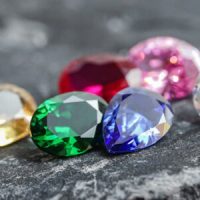
Color has the greatest influence on a sapphire’s value, and preferred sapphires have strong to vivid blue color saturation. The most valued blue sapphires are velvety blue to violet blue, in medium to medium-dark tones. Sapphires with these qualities command the highest prices per carat. Less valuable blue sapphires might also be grayish, too light, or too dark.
While the classic deep blue sapphire is perhaps the most iconic, sapphires come in a breathtaking array of colors, each with its own unique allure and value. These variations in color are due to the presence of different trace elements and the influence of various factors during the gemstone’s formation.
Sapphire Color Intensity
When it comes to evaluating the quality of a colored sapphire, color typically takes center stage. The intensity scale measures how saturated the hue appears in the gem, as well as its overall lightness or darkness. Among the various levels of intensity, “Vivid” is usually regarded as the most premium. That said, color perception is highly personal—what one person sees as perfect may differ from another’s preference. Beauty, after all, is in the eye of the beholder.
Sapphires Hue
Hue refers to the sapphire’s basic color, with blue being the dominant hue in blue sapphires. While a pure blue is most desirable, slight secondary hues like violet can enhance a stone’s vibrancy. In contrast, greenish or grayish hues typically reduce visual appeal and market value. Evaluating both dominant and secondary hues is essential to judging a sapphire’s true quality.
Sapphires Tone
Tone describes how light or dark a sapphire appears and plays a crucial role in its overall beauty. The ideal tone is medium to medium-dark, offering rich color without compromising brilliance. Sapphires that are too light may look pale and lack depth, while overly dark stones can appear nearly black, reducing their sparkle and visual appeal. Balanced tone enhances both color and luminosity, making it a key factor in evaluating quality.
Sapphires durability
Sapphires score a 9 on the Mohs scale of hardness, making them one of the toughest gemstones available—second only to diamonds, which top the scale at 10. This exceptional hardness makes sapphires an excellent choice for everyday jewelry and a strong alternative to diamonds, especially when compared to softer stones
LEARN MORE
Natural, Treated, & Synthetic
Sapphires are classified into four main types based on their origin and treatment: untreated, treated, synthetic, and simulant. Each type differs in how it is formed or enhanced, which directly affects its appearance, rarity, and value. Understanding these categories is key to recognizing the quality and authenticity of a sapphire
Sapphire Treatments
Sapphires are among the most coveted gemstones, admired for their vivid colors and durability. However, not all sapphires are created equal. Many undergo various treatments to improve their appearance. These treatments can significantly affect the gem’s value, longevity, and even how it should be cared for. Here’s a guide to the full spectrum of sapphire treatments—from the completely natural to the most intrusive.
Saturation in Sapphires
Saturation measures the intensity or purity of a sapphire’s color. High saturation results in vivid, lively stones with rich coloration, while low saturation produces grayish or muted sapphires that appear dull. Strong saturation, especially when paired with ideal tone and hue, is a hallmark of premium-quality sapphires.
Color Consistency
The evenness of color throughout a sapphire—known as color consistency—plays a significant role in determining its overall beauty and market value. A sapphire with uniform color distribution appears more harmonious and pleasing to the eye, as the hue, tone, and saturation remain consistent from edge to center. This even coloration allows the gem to display a cohesive and vibrant appearance when viewed from different angles and under various lighting conditions.
SAPPHIRE CLARITY
Unlike diamonds, which are assessed using a globally recognized grading system, sapphires and other colored gemstones do not follow an official clarity standard. In the gemstone world, clarity is typically judged with the naked eye, rather than under the 10x magnification standard used for diamonds. Clarity has an impact on sapphires prices and rarity. Sapphires typically have some inclusions and those with extremely high clarity are rare and very valuable.
VALUING SAPPHIRES
Saturation measures the intensity or purity of a sapphire’s color. High saturation results in vivid, lively stones with rich coloration, while low saturation produces grayish or muted sapphires that appear dull. Strong saturation, especially when paired with ideal tone and hue, is a hallmark of premium-quality sapphires.
Key Pages: Create & Customize Jewelry
Key Pages: Diamond Jewley From the Atelier
Essential Diamond & Jewelry Education
Important Links: Support & Policies
MyAntwerpDiamonds.com /
Some email responses from us may be filtered as spam or blocked altogether. To ensure you receive our emails, please provide your telephone or WhatsApp number for verification.




